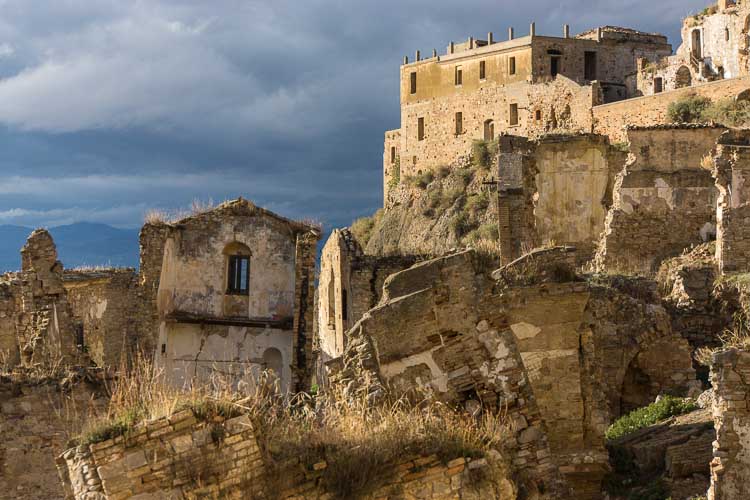Once you get untied from the traveler’s obligatory pilgrimages to Rome, Florence, Venice and the Cinque Terre you are free to consider other, more challenging excursions around the boot.
Perhaps you are now ready for a vacation does not fit with the nauseatingly frequent ad images of buttered and fit bodies joyously entwining while tiny little waves lap the shores of the curiously uninhabited beach in the background.
The narrative, like all narratives, needs a little disaster. A town crumbles and is abandoned. After a while it slowly begins to return to its native state, ashes to ashes, bricks to clay dust. But meanwhile, the earth’s stutters and lurches cause the straight lines of architectural order to give way to meandering voids and crazy tilts of artistic merit. Your eyes are curiously drawn to imperfections, as they might be to a certain Marilyn’s birthmark. You can’t help yourself. Add a mysterious light and the strange beauty is like nothing you’ve ever seen.

This is Craco, a town in Basilicata you should visit.
The next region to the left of Basilicata is Calabria. While working to squash bugs in my article with Karen Haid of Calabria: The Other Italy, I discovered another southern Ghost town. It’s called Pentedattilo, named after a five-fingered rock formation that makes a fine backdrop for the little village. You’ll find it on the edge of the Aspromonte Mountains on the southern tip of Calabria. This ghost town, however, has a story.
It was Easter in the year 1686. The Baron Bernardino Abenavoli had his heart set on marrying Antonietta Alberti, who had been born into the family of his archenemy. Not only was he in love with her, but a union between them might have helped heal the feud.
Well, this can’t end well. Thus, a story is told. Some of the story is rendered in clay by artist Nicola Tripodi of Arghilla’, who tells the story of this fascinating Calabria via some of the most interesting pottery I’ve ever come across. In this case he renders the scene as a five-fingered glove in which the various characters live and interact. There are different versions, some of which can be seen here along with other fine works from legends around the region.
The connection between the ghost town and potter’s clay interests me. As the town crumbles into its organic past, the art commemorating it rises from the trenches where clay is extracted before being turned into a form that might well last forever. I mean long after the earth is destroyed because industrialists won’t spend a cent on saving it from the filth their factories and inventions spew into the air, the pottery will remain to give an artistic hint as to the legends of the lost land for those future archaeologists from other planets who manage to find our overheated rock.
Our teasing tendrils of free thought can extend to the political uses of terracotta, too, by seeking out the fabulous terracotta whistles of the town of Rutigliano in Puglia. The south of Italy is alive with stories told in fascinating ways.
Here’s another tendril connecting art to the ghost town of Pentedattilo. You know W. C. Escher from his mind-bending mathematical and geometric forms, but he also traveled to Calabria in 1930 and produced a number of lithographs and woodcuts that represented the dramatic eeriness of the little village pressed up against the anthropomorphic rocks. And he did it also for another village you’ve never heard of but should visit, Pettorano in the Abruzzo.
It’s a small world in the south. It’s all connected. Tendrils everywhere. You gotta go follow some.